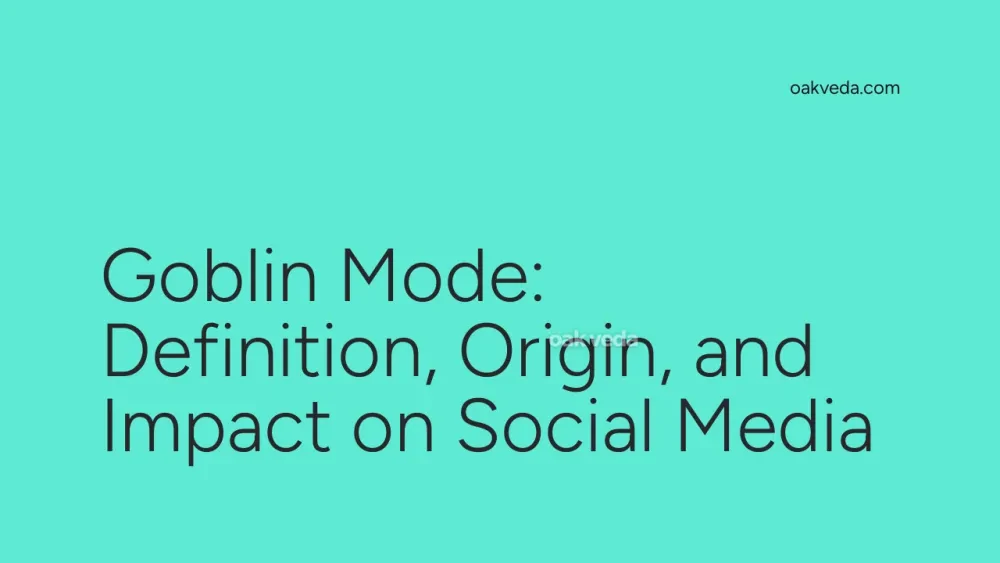
What is Goblin Mode?
"Goblin mode" is a popular social media term that describes a state of unapologetic self-indulgence, laziness, and rejection of societal expectations. This phrase encapsulates the attitude of embracing one's most basic, primal instincts without concern for appearance or social norms. When someone is in "goblin mode," they prioritize comfort, personal desires, and a carefree lifestyle over maintaining a polished public image.
Origin and Development of Goblin Mode
The term "goblin mode" first appeared on Twitter in 2009 but remained relatively obscure for over a decade. Its rise to prominence occurred in early 2022, catalyzed by a viral satirical tweet. This tweet falsely claimed that rapper Kanye West had ended his relationship with actress Julia Fox because she "went goblin mode."
The phrase quickly gained traction, resonating with many who found it perfectly captured their post-pandemic mindset. As people emerged from lockdowns and social restrictions, there was a collective shift towards prioritizing personal comfort and rejecting the pressure to always present a perfect image on social media.
The popularity and cultural significance of "goblin mode" were further cemented when Oxford Languages named it the Word of the Year for 2022. This recognition highlighted how the term had come to represent a broader societal mood and attitude.
How Goblin Mode Works
Embracing "goblin mode" typically involves:
- Prioritizing comfort over style or social expectations
- Indulging in "guilty pleasures" without shame
- Rejecting the pressure to maintain a curated social media presence
- Embracing messiness or disorder in one's personal space
- Choosing relaxation and self-care over productivity or social obligations
It's important to note that "goblin mode" is often used humorously or ironically. It's a way for people to acknowledge and even celebrate their less polished, more authentic selves.
Popular Examples of Goblin Mode
Some common scenarios that exemplify "goblin mode" include:
- Spending an entire weekend binge-watching TV shows in pajamas
- Eating junk food straight from the container while scrolling through social media
- Neglecting household chores in favor of pursuing personal interests
- Canceling plans to stay home and engage in solitary, comfort-focused activities
- Posting unfiltered, candid content on social media platforms
Impact of Goblin Mode on Social Media Culture
The rise of "goblin mode" has significantly influenced social media culture in several ways:
-
Authenticity Movement: It has contributed to a growing trend of authenticity on social platforms, encouraging users to share more genuine, unfiltered content.
-
Mental Health Awareness: The term has opened up conversations about self-care, work-life balance, and the importance of downtime in maintaining mental health.
-
Challenging Beauty Standards: By celebrating a less polished appearance, "goblin mode" has helped challenge unrealistic beauty standards often perpetuated on social media.
-
Humor and Relatability: The term has become a source of humor and relatability, with many users bonding over shared "goblin mode" experiences.
-
Shift in Content Creation: Influencers and content creators have started incorporating more casual, "goblin mode" content into their feeds, diversifying the types of content seen on social platforms.
Controversies or Debates Surrounding Goblin Mode
While largely embraced, the concept of "goblin mode" has sparked some debates:
-
Productivity Concerns: Some argue that celebrating "goblin mode" too much could lead to decreased productivity and motivation.
-
Mental Health Implications: There's discussion about whether prolonged periods of "goblin mode" could negatively impact mental health and social connections.
-
Commercialization: As the term gained popularity, concerns arose about its potential commercialization and loss of authentic meaning.
How Brands and Influencers Use Goblin Mode
Savvy brands and influencers have capitalized on the "goblin mode" trend:
-
Relatable Content: Creating content that showcases more casual, "behind-the-scenes" moments to increase relatability.
-
Product Marketing: Promoting comfort-focused products like loungewear, snacks, or home entertainment systems.
-
Mental Health Advocacy: Using the concept to discuss the importance of self-care and mental health breaks.
-
Humor and Memes: Developing humorous content around the "goblin mode" theme to engage audiences.
Future Trends Related to Goblin Mode
As social media continues to evolve, "goblin mode" may influence future trends:
-
Balanced Authenticity: A potential shift towards a middle ground between highly curated content and complete "goblin mode."
-
Niche Communities: The formation of online communities centered around embracing and celebrating "goblin mode" lifestyles.
-
Evolving Work Culture: Possible impacts on work culture, with increased acceptance of more casual, comfortable work environments.
-
New Vocabulary: The emergence of related terms or variations on "goblin mode" to describe different aspects of this lifestyle.
FAQs about Goblin Mode
-
Is "goblin mode" a negative term? No, it's generally used humorously or as a way to embrace one's authentic self.
-
Can "goblin mode" be harmful? While occasional "goblin mode" is harmless, prolonged periods might negatively impact mental health or productivity.
-
Is "goblin mode" only for social media? While popularized on social media, the concept applies to real-life behaviors and attitudes as well.
-
How can I explain "goblin mode" to older generations? Describe it as a modern way of taking a break from societal pressures and embracing comfort and authenticity.
-
Will "goblin mode" remain popular? While the exact term might evolve, the underlying concept of authenticity and self-care is likely to persist in social media culture.
In conclusion, "goblin mode" has become more than just a social media buzzword. It represents a cultural shift towards authenticity, self-care, and rejection of constant perfection. As social media continues to evolve, the impact of "goblin mode" on digital culture and personal expression is likely to be felt for years to come.
You may be interested in:
- Cringe: Definition, Origin, and Impact on Social Media
- Focus Groups: Definition, Origin, and Impact on Social Media
- Campsite.bio: Definition, Origin, and Impact on Social Media
- Thought Leader: Definition, Origin, and Impact on Social Media
- Social Media Etiquette: Definition, Origin, and Impact
- Social Media Algorithm: Definition, Origin, and Impact

